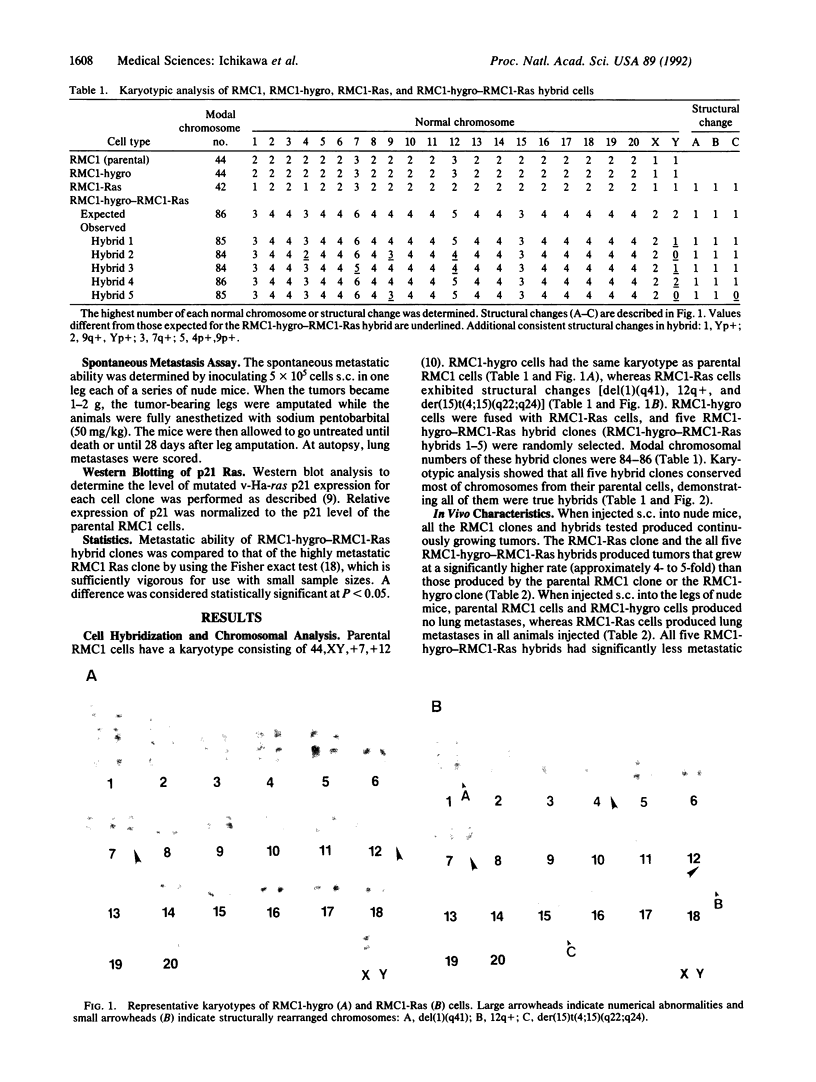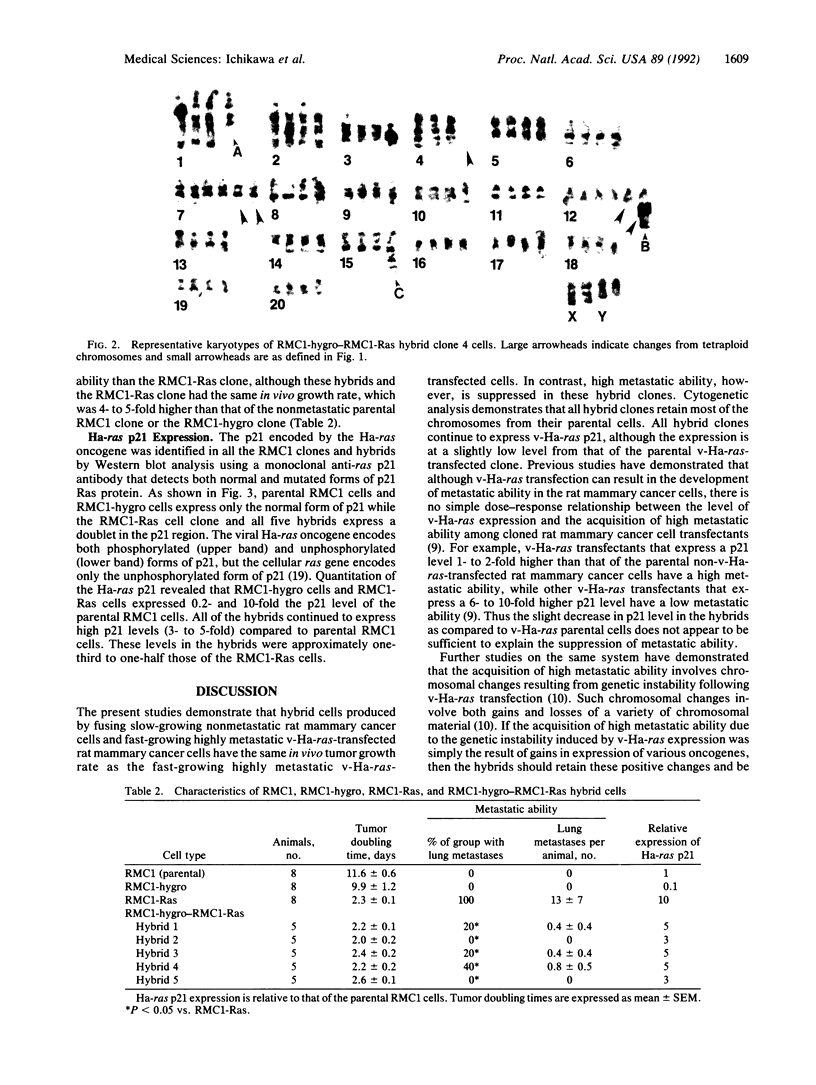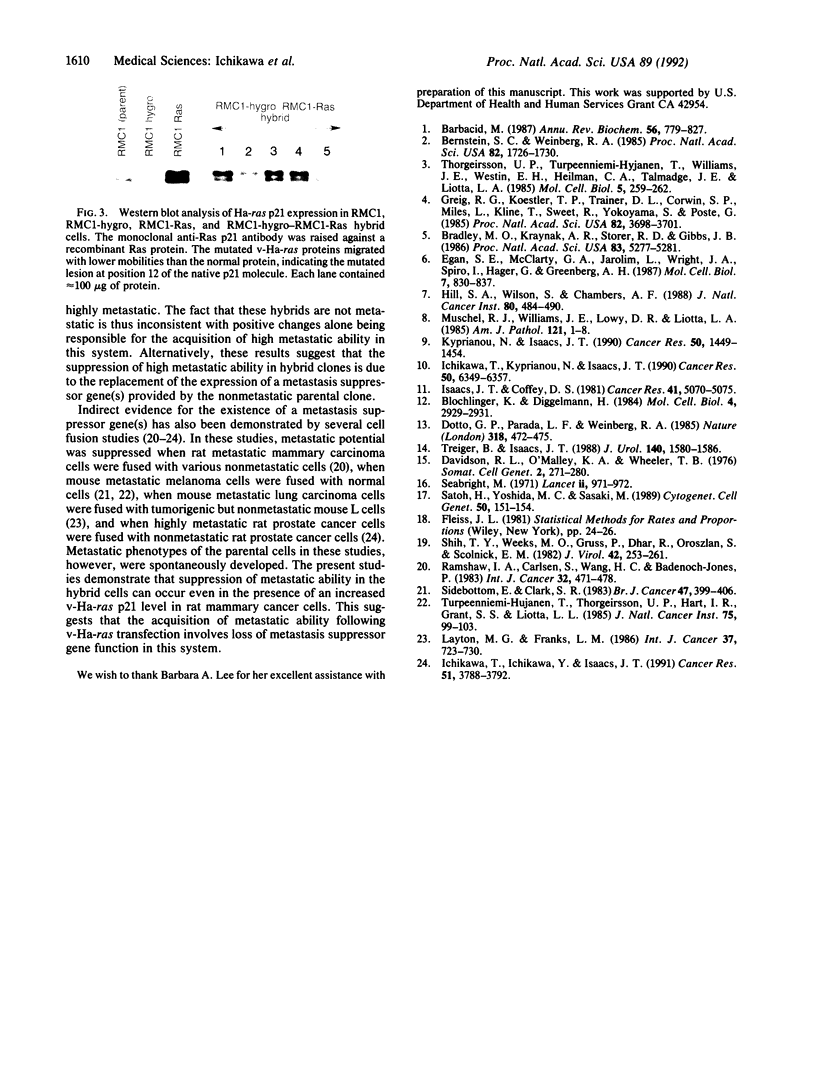Abstract
Following v-Ha-ras transfection of nonmetastatic dimethylbenz(( a ))anthracene-induced rat mammary cancer (RMC1) cells, occasional transfectants were isolated that acquired high metastatic ability. High metastatic ability is not a simple process regulated by v-Ha-ras p21 levels alone in these v-Ha-ras transfectants but involves the development of cytogenetic changes. If such cytogenetic changes involve only gain in gene expression, then all hybrids formed by fusing highly metastatic v-Ha-ras RMC1 transfectants with the parental nonmetastatic RMC1 should be highly metastatic. If loss of a metastatic suppressor gene(s) is also involved, then such hybrids should be nonmetastatic since chromosomes from the nonmetastatic parental cells should supply the suppressor function. To test this possibility, a highly metastatic cloned v-Ha-ras transfectant was fused with the nonmetastatic parental RMC1 cells. Five hybrid clones were isolated that conserved the chromosomes from their parental cells. When these hybrid clones were injected into animals, primary tumors developed with the same tumor-doubling time as that of the highly metastatic parental v-Ha-ras transfectant (i.e., approximately 2 days). High metastatic ability was, however, suppressed in these hybrid clones. All hybrid clones continued to express v-Ha-ras p21. Thus, suppression of metastatic ability in the hybrids can occur even in the presence of an elevated v-Ha-ras p21 level. This suggests that the acquisition of metastatic ability following v-Ha-ras transfection involves loss of metastasis suppressor gene function in rat mammary cancer cells.
Full text
PDF



Images in this article
Selected References
These references are in PubMed. This may not be the complete list of references from this article.
- Barbacid M. ras genes. Annu Rev Biochem. 1987;56:779–827. doi: 10.1146/annurev.bi.56.070187.004023. [DOI] [PubMed] [Google Scholar]
- Bernstein S. C., Weinberg R. A. Expression of the metastatic phenotype in cells transfected with human metastatic tumor DNA. Proc Natl Acad Sci U S A. 1985 Mar;82(6):1726–1730. doi: 10.1073/pnas.82.6.1726. [DOI] [PMC free article] [PubMed] [Google Scholar]
- Blochlinger K., Diggelmann H. Hygromycin B phosphotransferase as a selectable marker for DNA transfer experiments with higher eucaryotic cells. Mol Cell Biol. 1984 Dec;4(12):2929–2931. doi: 10.1128/mcb.4.12.2929. [DOI] [PMC free article] [PubMed] [Google Scholar]
- Bradley M. O., Kraynak A. R., Storer R. D., Gibbs J. B. Experimental metastasis in nude mice of NIH 3T3 cells containing various ras genes. Proc Natl Acad Sci U S A. 1986 Jul;83(14):5277–5281. doi: 10.1073/pnas.83.14.5277. [DOI] [PMC free article] [PubMed] [Google Scholar]
- Davidson R. L., O'Malley K. A., Wheeler T. B. Polyethylene glycol-induced mammalian cell hybridization: effect of polyethylene glycol molecular weight and concentration. Somatic Cell Genet. 1976 May;2(3):271–280. doi: 10.1007/BF01538965. [DOI] [PubMed] [Google Scholar]
- Dotto G. P., Parada L. F., Weinberg R. A. Specific growth response of ras-transformed embryo fibroblasts to tumour promoters. Nature. 1985 Dec 5;318(6045):472–475. doi: 10.1038/318472a0. [DOI] [PubMed] [Google Scholar]
- Egan S. E., McClarty G. A., Jarolim L., Wright J. A., Spiro I., Hager G., Greenberg A. H. Expression of H-ras correlates with metastatic potential: evidence for direct regulation of the metastatic phenotype in 10T1/2 and NIH 3T3 cells. Mol Cell Biol. 1987 Feb;7(2):830–837. doi: 10.1128/mcb.7.2.830. [DOI] [PMC free article] [PubMed] [Google Scholar]
- Greig R. G., Koestler T. P., Trainer D. L., Corwin S. P., Miles L., Kline T., Sweet R., Yokoyama S., Poste G. Tumorigenic and metastatic properties of "normal" and ras-transfected NIH/3T3 cells. Proc Natl Acad Sci U S A. 1985 Jun;82(11):3698–3701. doi: 10.1073/pnas.82.11.3698. [DOI] [PMC free article] [PubMed] [Google Scholar]
- Hill S. A., Wilson S., Chambers A. F. Clonal heterogeneity, experimental metastatic ability, and p21 expression in H-ras-transformed NIH 3T3 cells. J Natl Cancer Inst. 1988 Jun 1;80(7):484–490. doi: 10.1093/jnci/80.7.484. [DOI] [PubMed] [Google Scholar]
- Ichikawa T., Ichikawa Y., Isaacs J. T. Genetic factors and suppression of metastatic ability of prostatic cancer. Cancer Res. 1991 Jul 15;51(14):3788–3792. [PubMed] [Google Scholar]
- Ichikawa T., Kyprianou N., Isaacs J. T. Genetic instability and the acquisition of metastatic ability by rat mammary cancer cells following v-H-ras oncogene transfection. Cancer Res. 1990 Oct 1;50(19):6349–6357. [PubMed] [Google Scholar]
- Isaacs J. T., Coffey D. S. Adaptation versus selection as the mechanism responsible for the relapse of prostatic cancer to androgen ablation therapy as studied in the Dunning R-3327-H adenocarcinoma. Cancer Res. 1981 Dec;41(12 Pt 1):5070–5075. [PubMed] [Google Scholar]
- Kyprianou N., Isaacs J. T. Relationship between metastatic ability and H-ras oncogene expression in rat mammary cancer cells transfected with the v-H-ras oncogene. Cancer Res. 1990 Mar 1;50(5):1449–1454. [PubMed] [Google Scholar]
- Layton M. G., Franks L. M. Selective suppression of metastasis but not tumorigenicity of a mouse lung carcinoma by cell hybridization. Int J Cancer. 1986 May 15;37(5):723–730. doi: 10.1002/ijc.2910370513. [DOI] [PubMed] [Google Scholar]
- Muschel R. J., Williams J. E., Lowy D. R., Liotta L. A. Harvey ras induction of metastatic potential depends upon oncogene activation and the type of recipient cell. Am J Pathol. 1985 Oct;121(1):1–8. [PMC free article] [PubMed] [Google Scholar]
- Ramshaw I. A., Carlsen S., Wang H. C., Badenoch-Jones P. The use of cell fusion to analyse factors involved in tumour cell metastasis. Int J Cancer. 1983 Oct 15;32(4):471–478. doi: 10.1002/ijc.2910320414. [DOI] [PubMed] [Google Scholar]
- Satoh H., Yoshida M. C., Sasaki M. High resolution chromosome banding in the Norway rat, Rattus norvegicus. Cytogenet Cell Genet. 1989;50(2-3):151–154. doi: 10.1159/000132747. [DOI] [PubMed] [Google Scholar]
- Seabright M. A rapid banding technique for human chromosomes. Lancet. 1971 Oct 30;2(7731):971–972. doi: 10.1016/s0140-6736(71)90287-x. [DOI] [PubMed] [Google Scholar]
- Shih T. Y., Weeks M. O., Gruss P., Dhar R., Oroszlan S., Scolnick E. M. Identification of a precursor in the biosynthesis of the p21 transforming protein of harvey murine sarcoma virus. J Virol. 1982 Apr;42(1):253–261. doi: 10.1128/jvi.42.1.253-261.1982. [DOI] [PMC free article] [PubMed] [Google Scholar]
- Sidebottom E., Clark S. R. Cell fusion segregates progressive growth from metastasis. Br J Cancer. 1983 Mar;47(3):399–405. doi: 10.1038/bjc.1983.60. [DOI] [PMC free article] [PubMed] [Google Scholar]
- Thorgeirsson U. P., Turpeenniemi-Hujanen T., Williams J. E., Westin E. H., Heilman C. A., Talmadge J. E., Liotta L. A. NIH/3T3 cells transfected with human tumor DNA containing activated ras oncogenes express the metastatic phenotype in nude mice. Mol Cell Biol. 1985 Jan;5(1):259–262. doi: 10.1128/mcb.5.1.259. [DOI] [PMC free article] [PubMed] [Google Scholar]
- Treiger B., Isaacs J. Expression of a transfected v-Harvey-ras oncogene in a Dunning rat prostate adenocarcinoma and the development of high metastatic ability. J Urol. 1988 Dec;140(6):1580–1586. doi: 10.1016/s0022-5347(17)42131-8. [DOI] [PubMed] [Google Scholar]
- Turpeenniemi-Hujanen T., Thorgeirsson U. P., Hart I. R., Grant S. S., Liotta L. A. Expression of collagenase IV (basement membrane collagenase) activity in murine tumor cell hybrids that differ in metastatic potential. J Natl Cancer Inst. 1985 Jul;75(1):99–103. [PubMed] [Google Scholar]






